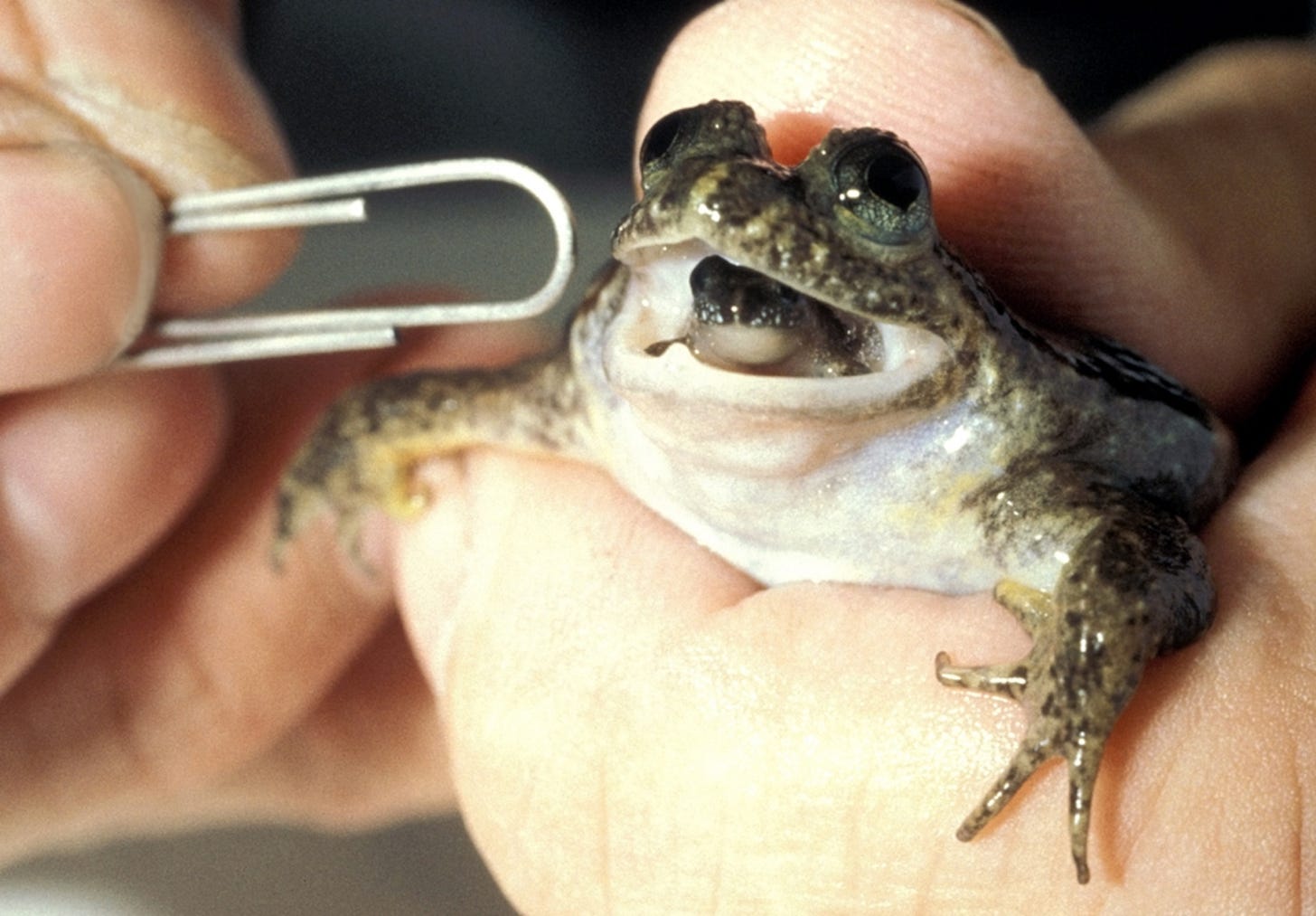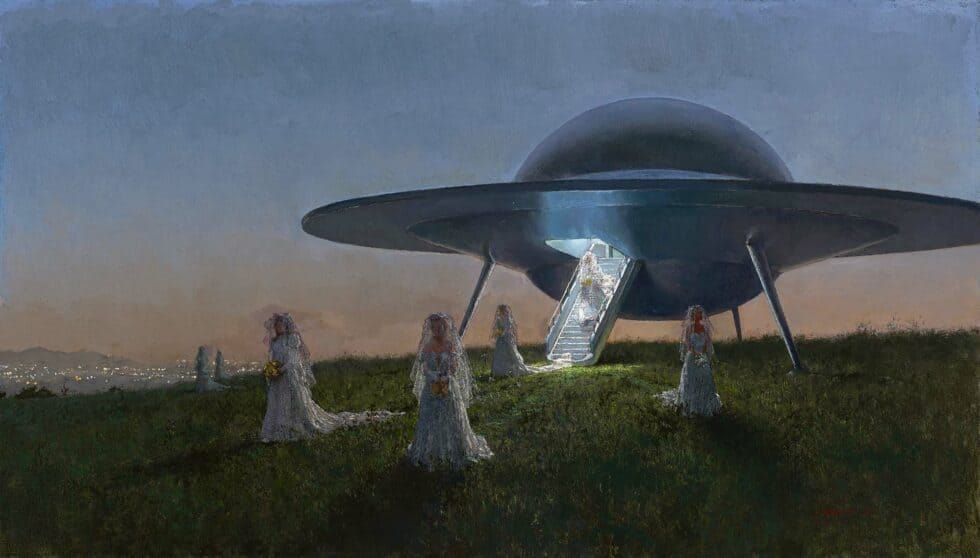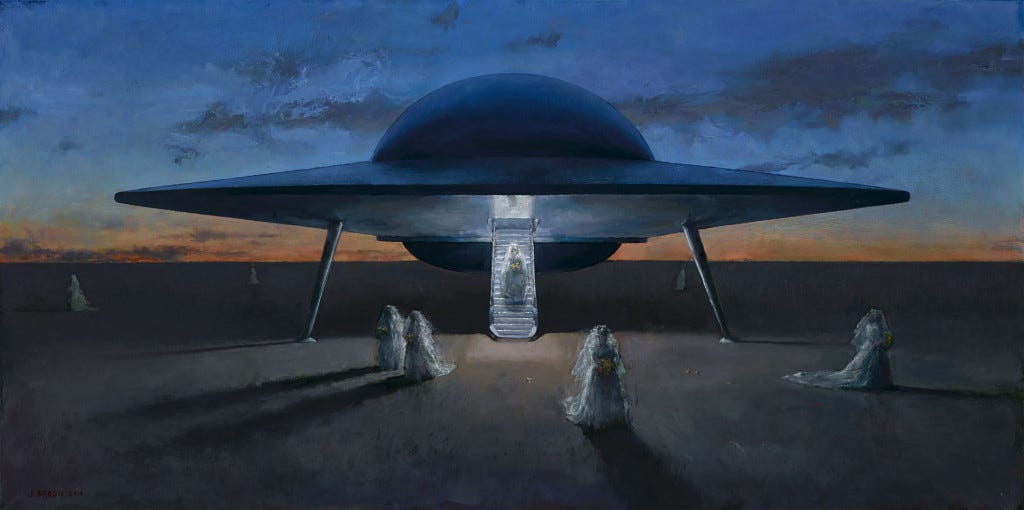Heads Up: this edition of “WRITING OF” contains some grotesque imagery. Viewer discretion is advised, yada-yada.
Minor Shopkeeping Note- I used to post these “writing of” essays over on my other blog, Poquessian, however I’ve decided to switch to publishing them here on my main blog. The first few of these will be free “taste-testers” but I am planning to eventually paywall such behind-the-scenes content, while the stories themselves remain free to read by all. Cheers!
Howdy! This is just a short little behind-the-scenes essay about my latest short story, In Bride’s Clothing- here I’ll cover the research, inspirations, the cover art, writing process, and a bunch of other stuff that went into writing this. And squids. Lots and lots of squids.
Obviously spoilers abound, so if you haven’t read the story already you can do so below:
In Bride's Clothing
The blue seas and white clouds of K-19C swirled below the saucer like a painting of some hallucinogenic wonderland. Coll, the Jemark of Vessel 247, always thought it looked far too chaotic compared to the peaceful landscape of Jora, where the seas had the decency to pool in round craters, and clouds were flecked sparingly across the gr…
Inspirations & Research
Very little research was required for this story. Mostly it was just taking stuff I already knew and found cool or interesting, and throwing it all together into a blender.
The most immediate inspiration for the Brides was the biological concept of aggressive mimicry, the specifics of which will be discussed a bit further down in the Jorite Biology section. Suffice to say for now, aggressive mimicry is ubiquitous across the whole spectrum of life- most famously in the anglerfish and Venus flytrap. The very title of the story is a reference to the innumerable parables and fables warning of this deceptive evolutionary and social strategy, the wolf in sheep’s clothing. The story’s original working title “Mimicry” was a bit more blatant about its origins in this creepy strategy.
Old Celtic faerie lore was also a huge influence- I mean the Brides are outright referred to as Changelings1, and their reproductive strategy, while not identical to Celtic changelings, does resemble it a good deal.
As far as fictional references, the Jorite ranks of Jemark and Jella were inspired by the Tharks and their Jeddaks from Edgar Rice Burroughs’ Barsoom series. Tars was actually named after Tars-Tarkas himself, though it is precisely here that any similarities between the proud warrior Tharks and deceptive predatory Jorites ends. Jellia, one of the Brides, was named after Jellia Jamb from L. Frank Baum’s Oz series- and I should note that Jamb is really a sweet girl and nothing at all like the monstrous predator in my story… I just liked the name.
One minor detail from later on in the story which I deliberately fudged was the inclusion of a Spanish mission as the spot where poor Joey meets his end. There is not and to my knowledge never has been any Spanish mission in Phoenix, Arizona. The closest one is San Xavier, in Tucson. It’s a tiny detail but I thought it worth noting, it is not factually accurate and was just a bit of artistic flair on my part.
The Jorite Homeworld
The Brides’ home planet of Jora was named after Jor-El, Superman’s father from Man of Steel.
The very brief environmental descriptions of Jora, having seas pooled in craters and purple vegetation and green skies, are all plausible descriptors of an alien environment, specifically a sparse, toxic world revolving around a red dwarf star-
Mars once had big “tubs” of water filling its craters, and these were likely some of the last places on the planet which had liquid water. Thus we can infer that Jora is a small, dry world whose remaining water is confined to large- when compared to the planet’s surface area- craters.
Purple vegetation would likely thrive better under the lower light conditions present around a red dwarf compared to green ones. There’s also a theory that the Earth’s own photosynthesizers were originally purple, and our current green plants only exist because they exploited the only part of the light spectrum not in use before the purple photosynthesizers went extinct. All fascinating stuff, possibly deserving of its own essay…
The planet’s green sky would be the result of a high concentration of hydrogen sulfide- this compound has caused hideous mass extinctions on Earth in the past, but there’s no reason an alien biosphere couldn’t be better adapted to it.
These details are of basically no relevance at all to the story, but it’s little stuff like this which in my view lends some verisimilitude to the otherwise silly premise of alien beings coming to Earth to digest its inhabitants as part of their breeding cycle. Which brings us to…
Jorite Biology
The biology of the Jorites was specifically modeled after three types of animals- spiders, cephalopods, and gastric-brooding frogs.
The references to spiders were pretty sparse, limited to the face, dentition, and genitalia (“palpal bulbs”), but cephalopods and the frogs were very influential to their designs.
Regarding octopi, the Jorites have tentacles obviously, but also their ability to change color depending on their emotions, and the plot-central ability of the Brides to so thoroughly mimic human females, were both directly inspired by octopi.
Octopi in general are extraordinarily good at camouflaging themselves from predators, but the mimic octopus specifically is the Earth’s indisputable master of disguise.
Here are some pretending to be, variously, a piece of coral, a sea snake, a stonefish, a lionfish, and a skate:


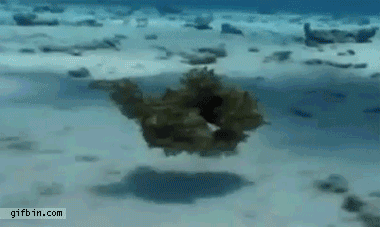
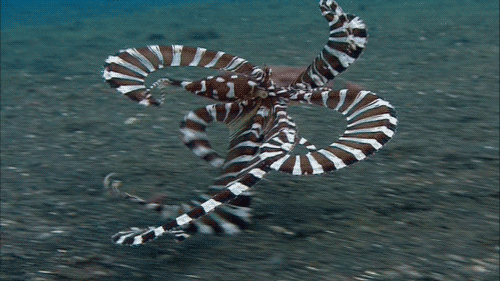
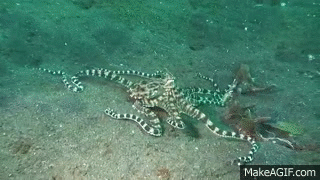
It’s scary how well they can blend in, and how intelligently and consciously they manipulate their forms.
Now these are all examples of defensive mimicry, adaptations to confuse or hide from potential predators. But it wasn’t a far leap at all to turn this into something very predatory, and from this the Brides were born.
The idea of the Brides having hypnotic eyes was taken from another cephalopod, the cuttlefish, which really do change their skin color in rapid succession in order to effectively hypnotize their prey.
I was at a loss for words when I learned they could do this- it’s so creepy and terrifying and ingenious; a beautiful testament to the unfathomable creativity of our Maker.
Since in humans the eyes are the main focus of attention and the windows to the soul, I thought it would be more fitting to limit the crazy color changes just to there. This was one of the key elements to making the story work, since it’s how the Bride lines up for the attack after carefully deceiving her prey.
The concept of the Brides having toxic skin was borrowed from the blue-ringed octopus, as well as poison dart frogs. The difference of course is that while these animals use their toxins to kill potential predators, the Brides use them to dull the wits of potential victims.
Mostly this element was inspired by legends of succubi and other supernatural temptresses, as well as just the general lust of men. I think most guys with a long enough “report card” have a story of that one girl who was able to completely disarm him- without neurotoxins!- and then proceeded to screw him over royally. The Brides are just that on steroids.
The Jorites’ very bizarre reproduction method, using an upper stomach chamber as a brooding pond for larval “tadfries”, is actually a real method used by certain frogs. Or at least, it was until the 1980s. Both species of gastric-brooding frog, native to Australia, are now extinct, likely due to habitat destruction via pollution. These bizarre amphibians really did carry their young in their stomachs until they were ready to hop out of their momma’s mouths and face the world. They had a chemical in their egg gelatin which turned off production of the mother’s stomach acid, turning the organ into a safe little “kiddie pool” for the babies. The mother would not eat while the young developed in her stomach, but would still move around at least a little bit to avoid predators and such.2
One thing I changed pretty late in the game was the descripton of the Jorite Bride’s mouth- the line “Her ghastly tallow mouth opening wider and wider, til it seemed her jaws were splitting apart at the seams” was initially “Her mouth opening wider and wider til it seemed her jaws were hinged like a treasure chest.”
This much better edit came about thanks to the following AI-generated tiktok video, posted by a friend of mine on Twitter, who used it to make the high-probability claim that LLMs are going to completely destroy the iPad generation’s perception of reality via disturbing and unreal imagery which will haunt them long into adulthood.
(And yeah that Heads Up in the intro was for this video, final warning)
As far as my friend’s point is concerned, I think another friend put it best- “I very much did not like seeing this, yet nothing could illustrate your point better.”
As far as I was concerned, however, this was almost precisely what I was thinking of with the biology of a Jorite female, and immediately went in and altered that one sentence to include her sickeningly pale mouth splitting open. This was the only “major” edit to be made to the story after completion of the first draft.
With all of this in mind…
These very rough and not-to-scale sketches, taken professionally from my phone3 are what I had in mind with the Jorites. Note that they do technically have eight tentacles, just like real octopi- two of them are intertwined to form a columnar leg, with snail-esque “diplopods” upon which they ooze along. The Brides use their uppermost set of tentacles as their arms, while the others are kept hidden and used to enhance the disguise’s bust and hips, making them that much more enticing to any poor saps who encounter them. The entire face is pure disguise, with eye and lip spots, and the whole head is considerably squished in to mimic the dainty nose and cheek and bone structure that men go crazy for.
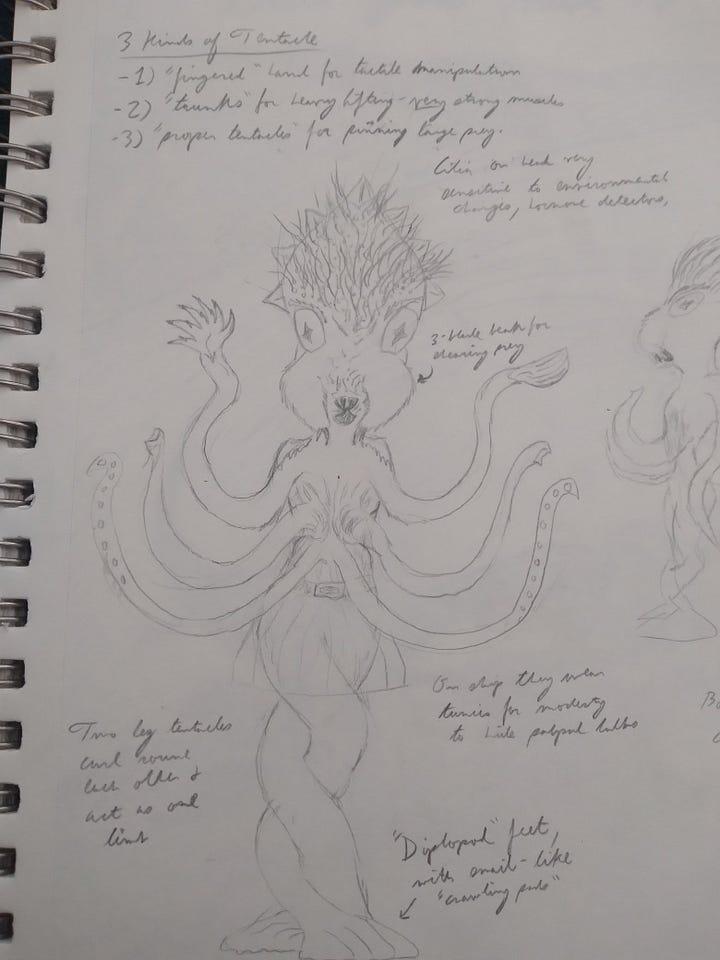
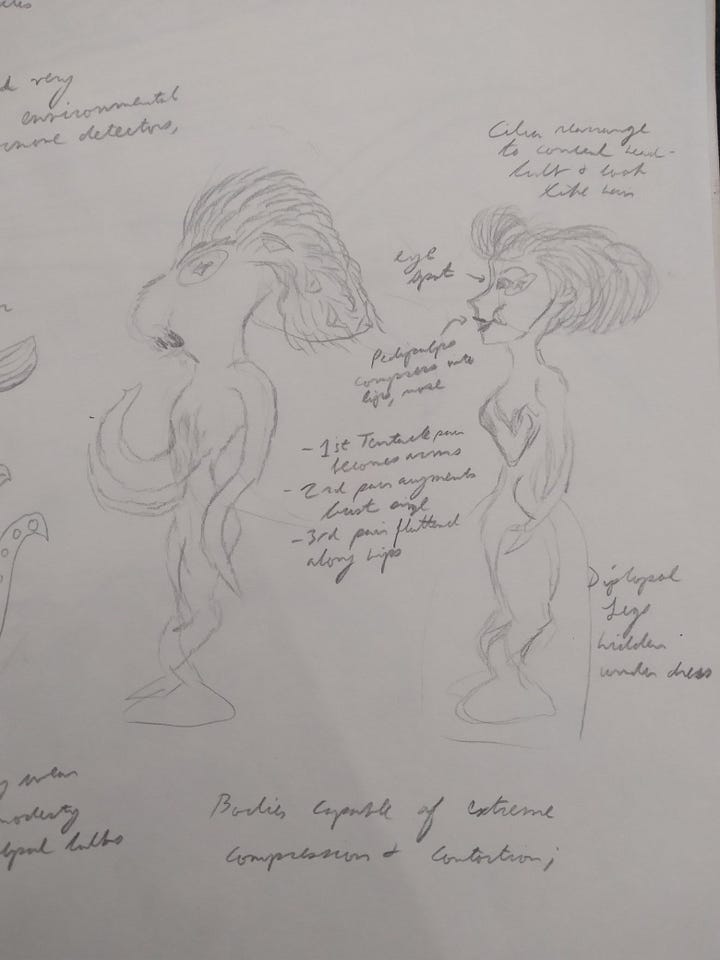
Some of this biology didn’t make it into the final story- it was too short and tight to include everything- but I had a lot of fun designing these repulsive buggers.
Cover Art
This excellent- and oddly untitled- painting by John Brosio is what initially inspired the story. I saw it in the galleries on his site and immediately began wondering “Why would a bunch of brides be disembarking a flying saucer?”
Naturally, it became the cover art.
There are two other great “paranormal bride” paintings by John in the gallery which do have titles. The first is titled The Seed, the second Bride in Headlights. As of now I have no intention of writing a sequel to In Bride’s Clothing, but if I ever do get an idea decent enough to warrant one, at least I won’t be wanting for more cover art.
Writing Process & Analysis
This story was so efficiently written it makes me feel bad about my other projects. I began on April 17 with a very loose plot outline, which read as follows:
aliens skinsuit as human women dressed in bridal gowns because this is the “mating garb/garment” of humans, and they need human seed to replenish their race.
the aliens actually look like disgusting crosses between frogs and cuttlefish
one of the alien women approaches a young man in Phoenix and uses hypnotic cuttlefish eyes to seduce him
Almost immediately the premise was altered from the female Jorites seducing human males to feeding upon them instead. Per the draft history, I began writing the story at 8:11AM on April 18, and was finished the first draft by 12:18PM. That first draft was about 90% of what actually wound up being published; very little editing was required, as it wasn’t the usual “first draft dreck” we writers all love to complain about.
Around 200 more words were added the next day, mostly at the front end of the story to add a bit more to Coll and Tars’ father-son relationship, anthropomorphizing them to make what was coming seem even more awful. The goal was to initially present the aliens as, while suspicous, nonthreatening, only for the audience to be confronted quite suddenly with the disgusting reality of their mission.
I then proceeded to sit on the story for months, as part of my effort to build up a backlog of finished works which I can publish at leisure while working on other projects. This was the first of them to be released. I hauled it out of the archive the day before publication, made a few minor edits during the final onceover, and published. Presto. Would that I were able to write all of them as neatly as this…
I hope- for those of you who made it this far- that this wasn’t too boring a read, or that it felt overly indulgent. I always enjoy when other writers and artists discuss their own techniques and inspirations, so I figure there’s a small chance you guys might enjoy hearing a bit about mine.
That’s all. You can go home now.
Minor Shopkeeping Note- I used to post these “writing of” essays over on my secondary blog, Poquessian, however I’ve decided to switch to publishing them here on my main site. The first few will be free “taste-testers” but I am planning to eventually paywall such behind-the-scenes content, while the stories themselves remain free to read by all.
Somewhat embarrassingly, for some reason I wrote that word six times as “Changling” in the published version of the story, and only corrected it the day after. Oh well.
Interestingly, while the gastric-brooding frog was the only species on Earth known to brood its young in its actual stomach, it wasn’t the only frog to ever decide the safest place to brood its young was inside it. Darwin’s frog, which thankfully is still with us, also came up with this very weird analogue to mammalian pregnancy- in that species, the male frog swallows the newly fertilized eggs and stores them in his vocal sac until they’re ready to hop out. It really forces one to wonder if any prehistoric amphibians devised a similar method of reproduction, especially those odd Permian temnospondylls which lived much of their lives completely on land.
I swear guys I’m going to learn how to use a scanner soon…




